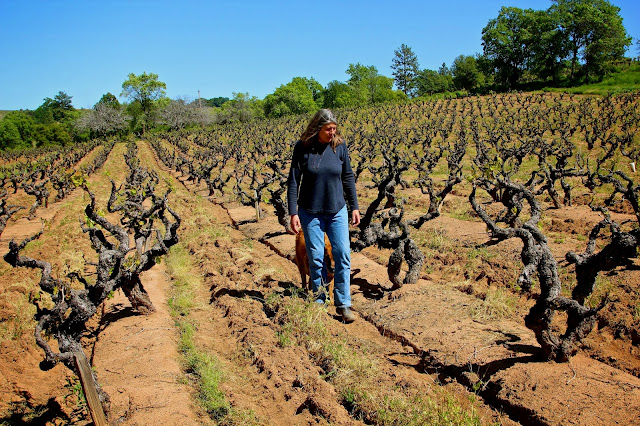Dear sommeliers: It's now okay to like Zinfandel
 |
| Typically small cluster of Zinfandel grown in old vine growths (in the Lodi appellation, vineyards planted between the 1880s and 1960s). |
This op is written from a sommelier's pespective. I know a lot of them because I was a sommelier, working in restaurants for over 28 years, and through one of my current affiliations (particularly The SOMM Journal).
And this I can say about sommeliers: Most of them hate Zinfandel.
Or putting it more gently: Of all the popular varietal categories, Zinfandel is the one for which sommeliers have the hardest time drumming up enthusiasm. Sure, the cultivar has historic connotations as "America's" grape, even though we now know it originated in Croatia. It's historical because, in the 1800s, Californians found that it was the easiest of all grapes to grow in the state's Mediterranean climate, and produced the most consistently good wine. That's a terroir-based relationship, isn't it? Aren't sommeliers into terroir?
Somewhere between the 1970s and 1980s, however, the varietal became a caricature of itself. "Big" styles, made from ultra-ripe grapes, became the most popular. "No wimpy wine" became a mantra, and varietal character was identified as "jammy." If grape sugars were too high to get wines lower than 17% ABV, no problem. Winemakers simply added water, adjusted acidity, and tacked on a ton of oak flavor—preferably American oak, adding sweetly vanillin, charred, dill-like, and often furniture polish-like qualities—and that was the formula for "America's wine."
%20harvest%20-%20winemaker%20Tegan%20Passalacqua%20(right)%20(1).jpeg) |
| Turley/Sandlands winemaker Tegan Passalacqua (right) harvesting Zinfandel in Steacy Vineyard (Mokelumne River-Lodi block first planted in 1907). |
Then there's the common practice of blending Petite Sirah, anywhere from 10% to over 20% for most commercial Zinfandels, which adds color, tannin, blacker fruit and spice qualities, but has as little to do with the pure taste of Zinfandel as oak barrels. Petite Sirah is an embellishment, nothing more, but somewhere along the line it became the expected thing, along with jammy fruit and chunky wood.
Most Zinfandel is still made this way. The good news is that more and more of them aren't. Just over ten years ago, for instance, Turley Wine Cellars—once the poster child for huge, jammy Zinfandels—began taking control of their own vineyard sources. Once they were able to grow grapes with more ideal sugar/acid levels, their vineyard-designate wines became fresher, more floral—pure Zinfandel is more flowery than jammy—and delineated in terms of vineyard-related qualities. As terroir-distinctive, in fact, as any American Pinot noir, and more so than most Cabernet Sauvignons.
Turley, like Ridge Vineyards, still employs a little new oak (20-25%) in its cooperage program, but at least their Zinfandels now taste like, well, "Zinfandel," and not something pumped up by vinous equivalents to steroids. There are now numerous other handcraft brands that age strictly in neutral wood, and pick grapes earlier in order to stick to native yeast fermentation (as Turley and Ridge have always done) and to retain a more natural acid-driven edginess. Progress.
 |
| Visiting Texas sommelier experiencing naturally fermented, neutral French oak aged Zinfandel in the place of its origin, Marian's Vineyard (own-rooted Mokelumne River-Lodi growth planted in 1901). |
Zinfandels need no longer be fat, sweetly fruited and oaky—the things sommeliers hate most. While many of the popular brands are still made that way, there are now lots of choices that are the opposite: Zinfandels as zesty, balanced and food-versatile as any Pinot noir. In fact, in my experience as a restaurateur, more food-versatile than most Pinot noirs.
Napa and Sonoma-grown Zinfandels are still the sturdiest in tannin, and can be quite big and ripe; but these qualities are dictated by their hillside or clay soil origins, not winemaker decisions or brand styles. You can now buy single-vineyard bottlings grown in Lodi or Contra Costa County that are soft yet zesty, red fruited and earthy—qualities that are byproducts of sandy soils. Paso Robles Zinfandels tend to be very ripe but minerally, with surprising acidity—reflections of their own unique terroir, often couched on high-pH, calcareous slopes.
Point being, many of the contemporary style Zinfandels crafted in serious styles—meant to express a place or artistry, not a stock image of what constitutes "Zinfandel"—are more than worthy of the attention of the most persnickety sommeliers. The big challenge now, of course, is to finally convince them.






Comments